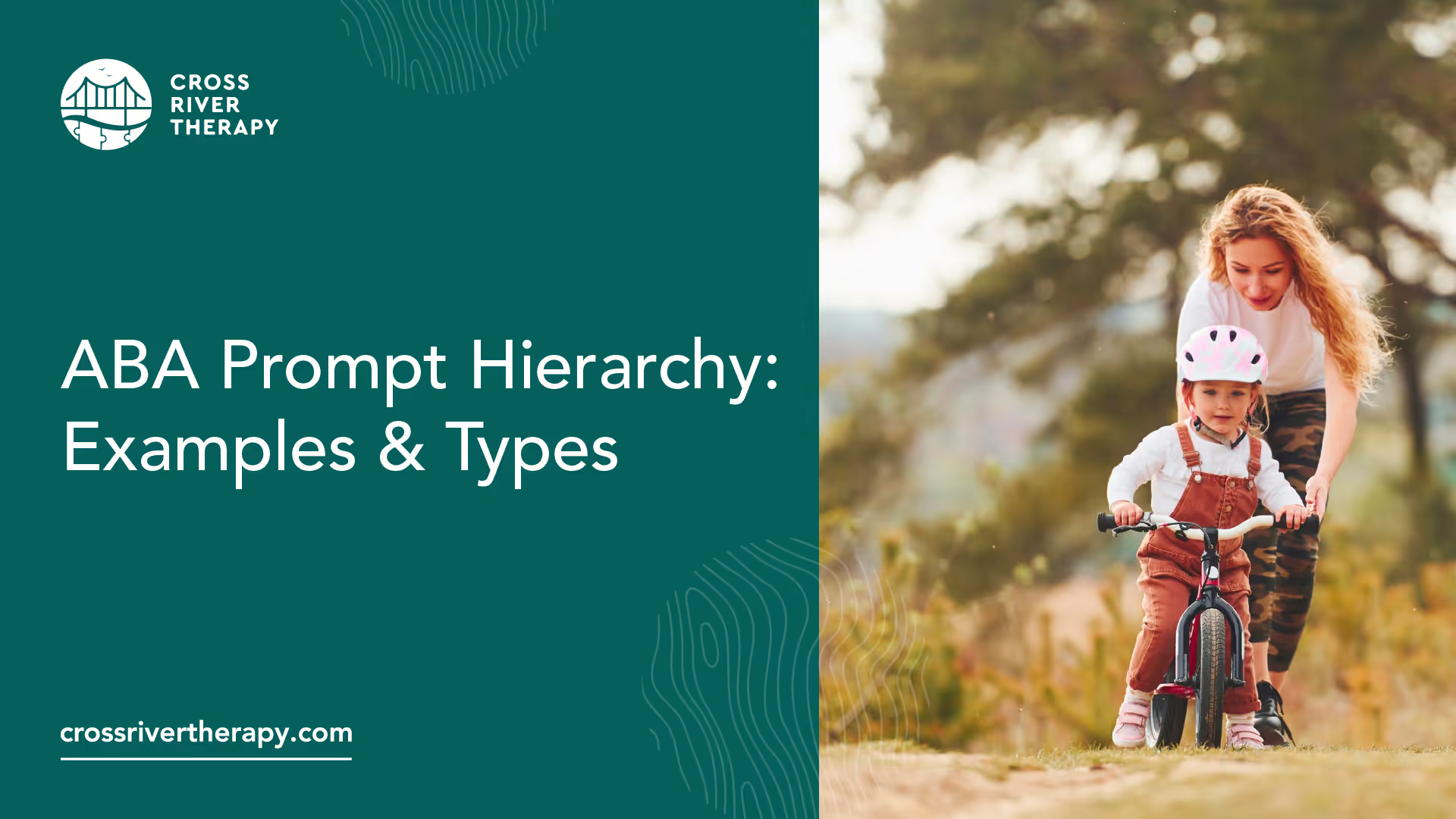ABA Prompt Hierarchy: Examples & Types
In the practice of Applied Behavior Analysis, prompts are the primary activity used.
.avif)
What is the ABA Prompt Hierarchy?
In the practice of Applied Behavior Analysis, prompts are the primary activity used.
Its practice is ubiquitous in the field. Everyday people also use them, sometimes without even realizing it. This applies to practice in every age group, in various stages of learning abilities.

Prompts help people in learning novel skills to later have the ability to practice them independently.
Common activities like a student learning a new programming language, teaching a toddler how to clean themselves after using the bathroom, or taking in the knowledge of a prompt hierarchy mandate skill to be successfully carried out.
They're learned through prompt usage and narrowed down to the ability that's coached.
It's the same for kids and older people suffering from learning disabilities that need extra assistance while taking in something new.
Such people face difficulties in adapting communication and social abilities, which are needed for one to go about life on their own without supervision by others.
Keep reading to understand more about prompt hierarchy, examples of its practice, and details on ways that it's carried out in different areas of expertise.
Advantages of Understanding Prompts
Accurate responses from using prompts boost the chances of getting close to reinforcement for the response that the practitioner wishes to see. It grows the desired behavior in the company of the Discriminative Stimulus, or instructional cue.
This means that prompts are very useful when teaching someone with a disorder a skill. It helps the patient to better understand what the correct response should be and how it'll get them to achieve what they want in the end.
This could be anything from a lunch break, their favorite food, or verbal praise.
However, errors can happen as well, lowering the persistence of reinforcement during every try. As children, everyone has run into problems when learning something new that's very challenging. The amount of skill needed to eventually overcome it could be great.
The level of prompts and support needed for the level of helpfulness can also be high. If such support wasn't available whatsoever, the outcome of success could considerably change or even fail.
Another example is the multiple branches presented to a patient to learn a skill, which ends in failed attempts every time.
Very quickly, this could result in lots of frustration and lower morale to continue trying to learn it, even for tasks that later come after it.
Prompting hierarchies are crucial for teachers that are working with people diagnosed with cognitive disorders.
Studies often show emphasis on the way prompts lower agitation while learning challenging tasks. Reducing errors can also shrink the chances of certain behaviors while they're in session.
The chances of successfully closing out the session can depend on the strategy during the patient's process of learning, with prompts being very useful for increasing the likelihood.
The Meaning of Prompt Procedure
Prompts are practices that help ordinary people and patients take in new skills which are meant to boost their independence.
In ABA, they're also closely linked with antecedent practices aimed at preventing certain behaviors from manifesting. They're used to mitigate bad responses and make good ones more frequent.
When someone waves to another person they consider to be friends, the action of waves is the response. Praise typically follows after that by the friend waving back or saying hello.
This is a simple but accurate example of a prompt procedure. The act of waving is also seen as a consequence. But what happens if they can't repeatedly react to instruction, such as during the wave? This is where a prompt is used further to encourage a better response.
6 Types of ABA prompts
Here are all the different types of ABA prompts used around the world to help children diagnosed with autism.
1. Physical Prompts
This happens when a student must be guided to a response through physical activity such as a gesture of some sort. Think of a handshake or a waving, as previously mentioned.
Another instance is when students are taught exercise, which begins with a prompt through using both hands. One hand would then change to using the wrists. From there, the hand would change to the elbow, then fade out as the student became better at the activity.
Life skills can also be taught through physical prompts. Think of when a child is taking cooking classes in home economics.
The teacher could observe the student by showing them how to move their wrists to stir certain foods. Once they pick up on what to do, the teacher then fades out and allows the students to keep at it on their own.
2. Model Prompt
This teaches a student what should be done before they carry out an activity. This is useful when taking in new social abilities. Appropriate social actions can be modeled through their peers, which are copied by the student when they see someone else perform an activity.
3. Gesture Prompt
Gesturing prompts are when someone shows what the right response is to any given instruction from a teacher. If a student is asked to search for a vehicle in a deck of cards with artwork for various objects, the teacher could point to the correct card so they know which one to look for later on.
Gesture prompts are easily foldable, particularly through using time delays or moving one's hand or finger gradually away from an object.
4. Verbal Prompt
Often used as a final device for prompting, verbal prompts are more challenging for the teacher to fade from, especially for small children.
5. Visual Prompt
When prompts are added to photos or texts on a computer or mobile device, they count as visual prompts. But it doesn't end there, even grocery lists on a piece of paper are defined as visual prompts.
Other items include digital alerts on a phone, notifications, and even errands listed in a daily planner. They help to give the user a visual aid that feeds personal and is easy to fade away from.
Think about when a teacher encourages a student to answer a question about the duties of a school counselor. The teacher can write on a blackboard that counselors help students focus on their educational objectives.
When the answer is shown on the board. it serves as a prompt that's faded through removing certain letters from the answer or writing them again in a way that's difficult to see.
6. Positional Prompt
When an instructor places the right response in an area that's close to the student in a way that helps them with info about the correct answer, it's called a positional prompt. When only a small amount of prompting is used to reach a goal, the teacher's efforts are considered a success.
It allows them to avoid becoming too dependent on prompts to carry out their objectives. They're best done when students are close to responding with a wrong answer, give no response whatsoever, or do respond but with an unfavorable answer.
Examples of Prompts in ABA
When ABA therapists use prompts, the ultimate goal is in using the prompt that's the least intrusive to the student's aims to get themselves to the teacher's goal.
The types of prompts an ABA therapist will use can change according to different sets of factors, such as the environment of the patient. The prompts must be carefully weighed so that they know which will help individual clients out the most.
There are circumstances where a therapist will use a prompt only if the patient provides an unfavorable response to it. The prompt could also be provided if the patient cannot give the correct answer to a certain subject within a set timeframe.
To successfully use prompts, an ABA therapist begins by pinpointing the behavior they wish to target. Once that's done, the best prompts for it are chosen. The order usually begins with prompting first, reinforcing second, and fading last.
Here are the prompts most used by ABA therapists to teach their patients that have problems eating with utensils:
- Verbal prompt - This can include commands such as the therapist telling them to pick up their spoon. Alternatively, they can refrain from mentioning the spoon by questioning what the patient will use to eat a certain meal that requires the use of a spoon.
- Gestural prompt - The therapist can point to a piece of silverware or make a specific gesture that gives the patient the impression of using one or even forming the shape of one with their hands.
- Modeling prompt - At an ABA center, this can involve standing directly behind the patient to help them finish an objective. In this case, it would be to pick up a spoon that they need to begin eating a meal.
- Full physical prompt - When a therapist takes their hand and places it on that of the patient to guide them towards the location of an eating utensil, they're exercising a physical prompt.
- Partial physical prompt - This is when the therapist uses their hand to move the patient's hand towards the spoon, but in a way where they stop before getting to the utensil's location.
- Visual prompt - Visual prompts are easy to practice for a therapist but can be hard for them to fade from. The process is done through only a picture being shown of the utensil.
- Positional prompt - The therapist would take the utensil and place it near the patient's hand.
Recent News
Related articles

Working With Autistic Children: 10 Career Options
Want to work with autistic children? Here are 10 career options for you to consider.

What Is The Age Limit For ABA Therapy In Indiana?
Find out what the age limit is for receiving Applied Behavior Analysis (ABA) therapy in Indiana.

What Is The Age Limit For ABA Therapy In Arizona?
Find out what the age limit is for receiving Applied Behavior Analysis (ABA) therapy in Arizona.

Verbal Operants In ABA: Definition & Examples
In Applied Behavior Analysis, verbal operants are a type of verbal behavior.

Token Economy: Examples & Applications in ABA
A token economy is a procedure that was developed to help reduce maladaptive behaviors and increased desire behaviors by providing a tangible conditioned reinforcer.

Trigger Analysis In ABA: Definition & Examples
Trigger analysis is a segment of ABA therapy where children are taught by therapists to pinpoint the behaviors and emotions that happen before, during, and after an event that takes place.

Variable Ratio Schedule & Examples
A variable-ratio schedule is a random reinforcement where responses are reinforced following varied responses afterward.

Task Analysis In ABA Therapy: Examples & Strategies
Task analysis is a process of teaching that divides complicated activities into sections involving easier steps for students to more easily take.

Stimulus Equivalence In ABA: Definition & Examples
Stimulus equivalence shows how relationships can manifest among different types of stimuli in different situations.

Speech Therapy For Autism: ABA vs. Speech Therapy
ABA therapy can help individuals with speech impairments learn to better identify and utilize the language skills they already have.

Stimulus Control Transfer ABA: Definition & Examples
Stimulus control is defined as an expression used to detail circumstances where a behavior is triggered by the existence or absence of a stimulus.

Social Validity In ABA: Definition & Examples
Social validity is the acceptance of interventions concerning behavioral changes.

